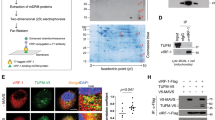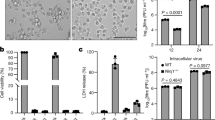Abstract
The 2‐5A system (2-5OAS/RNaseL) is composed of the 2′,5′oligoadenylate synthetase 1 (2-5OAS1) and 2-5A-dependent RNase (RNaseL), enzymes that play a key role in antiviral defence mechanisms. Activation of the 2-5A system by double stranded RNA (dsRNA) induces degradation of ribosomal RNAs and apoptosis in mammalian cells. To obtain further information into the molecular mechanisms by which RNaseL induces apoptosis, we expressed human RNaseL and 2-5OAS in HeLa cells using recombinant vaccinia viruses as vectors and we analysed in detail different biochemical markers of apoptosis. In this expression virus-cell system the activation of RNaseL, as index of rRNA degradation, is an upstream event of apoptosis induction. RNaseL induces apoptosis in a caspase-dependent manner (caspases 8, 9 and 2). At the beginning of apoptosis RNaseL and 2-5OAS are localized in the mitochondria and cytosol fractions, while at the onset of apoptosis both enzymes are largely in mitochondria. The 2-5A system induces the release of Cytochrome c from mitochondria to cytosol in a caspase dependent manner. The onset of apoptosis elicits the disruption of mitochondrial membrane potential (ΔΦm), as well as the generation of reactive oxygen species (ROS). Moreover, the activation of RNaseL induces morphological alterations in the mitochondria. Apoptosis induced by the 2-5A system involves mitochondrial proteins, such as the human anti-apoptotic protein Bcl-2, which blocks both the apoptosis and the change of ΔΦm induced by the activation of RNaseL. These findings provide new insights into the molecular mechanisms of apoptosis induction by the 2-5A system, demonstrating the importance of mitochondria in 2-5OAS/RNaseL-induced apoptosis.
Similar content being viewed by others
References
Goldstein JC, Waterhouse NJ, Juin P, Evan GI, Green DR. The coordinate release of Cytochrome c during apoptosis is rapid, complete and kinetically invariant. Nat Cell Biol 2000; 2: 156.
Samuel CE. Antiviral actions of interferons. Clin Microbiol Rev 2001; 14: 778.
Der SD, Zhou A, Williams BR, Silverman RH. Identification of genes differentially regulated by interferon alpha, beta, or gamma using oligonucleotide arrays. Proc Natl Acad Sci USA 1998; 95: 15623.
Geiss G, Jin G, Guo J, Bumgarner R, Katze MG, Sen GC. A comprehensive view of regulation of gene expression by double-stranded RNA-mediated cell signaling. J Biol Chem 2001; 276: 30178.
Diaz-Guerra M, Rivas C, Esteban M. Inducible expression of the 2-5A synthetase/RNase L system results in inhibition of vaccinia virus replication. Virology 1997; 227: 220.
Rebouillat D, Hovanessian AG. The human 2′,5′-oligoadenylate synthetase family: Interferon-induced proteins with unique enzymatic properties. J Interferon Cytokine Res 1999; 19: 295.
Marie I, Rebouillat D, Hovanessian AG. The expression of both domains of the 69/71 kDa 2′,5′ oligoadenylate synthetase generates a catalytically active enzyme and mediates an anti-viral response. Eur J Biochem 1999; 262: 155.
Zhou A, Paranjape JM, Hassel BA, et al. Impact of RNase L overexpression on viral and cellular growth and death. J Interferon Cytokine Res 1998; 18: 953.
Le Roy F, Bisbal C, Silhol M, Martinand C, Lebleu B, Salehzada T. The 2-5A/RNase L/RNase L inhibitor (RLI) [correction of (RNI)] pathway regulates mitochondrial mRNAs stability in interferon alpha-treated H9 cells. J Biol Chem 2001; 276: 48473.
Carpten J, Nupponen N, Isaacs S, et al. Germline mutations in the ribonuclease L gene in families showing linkage with HPC1. Nat Genet 2002; 30: 181.
Silverman RH. Implications for RNase L in prostate cancer biology. Biochemistry 2003; 42: 1805.
Diaz-Guerra M, Rivas C, Esteban M. Activation of the IFN-inducible enzyme RNase L causes apoptosis of animal cells. Virology 1997; 236: 354.
Castelli JC, Hassel BA, Maran A, et al. The role of 2′-5′ oligoadenylate-activated ribonuclease L in apoptosis. Cell Death Differ 1998; 5: 313.
Tan S, Sagara Y, Liu Y, Maher P, Schubert D. The regulation of reactive oxygen species production during programmed cell death. J Cell Biol 1998; 141: 1423.
Green DR, Reed JC. Mitochondria and apoptosis. Science 1998; 281: 1309.
Waterhouse NJ, Ricci JE, Green DR. And all of a sudden it's over: Mitochondrial outer-membrane permeabilization in apoptosis. Biochimie 2002; 84: 113.
Wang X. The expanding role of mitochondria in apoptosis. Genes Dev 2001; 15: 2922.
Zamzami N, Marchetti P, Castedo M, et al. Reduction in mitochondrial potential constitutes an early irreversible step of programmed lymphocyte death in vivo. J Exp Med 1995; 181: 1661.
Voisine C, Craig EA, Zufall N, von Ahsen O, Pfanner N, Voos W. The protein import motor of mitochondria: Unfolding and trapping of preproteins are distinct and separable functions of matrix Hsp70. Cell 1999; 97: 565.
Ricci JE, Gottlieb RA, Green DR. Caspase-mediated loss of mitochondrial function and generation of reactive oxygen species during apoptosis. J Cell Biol 2003; 160: 65.
Rusch L, Zhou A, Silverman RH. Caspase-dependent apoptosis by 2’,5’-oligoadenylate activation of RNase L is enhanced by IFN-beta. J Interferon Cytokine Res 2000; 20: 1091.
Waterhouse NJ, Goldstein JC, von Ahsen O, Schuler M, Newmeyer DD, Green DR. Cytochrome c maintains mitochondrial transmembrane potential and ATP generation after outer mitochondrial membrane permeabilization during the apoptotic process. J Cell Biol 2001; 153: 319.
Rodriguez JF, Smith GL. Inducible gene expression from vaccinia virus vectors. Virology 1990; 177: 239.
Martin AG, Fearnhead HO. Apocytochrome c blocks caspase-9 activation and Bax-induced apoptosis. J Biol Chem 2002; 277: 50834.
Castelli J, Wood KA, Youle RJ. The 2-5A system in viral infection and apoptosis. Biomed Pharmacother 1998; 52: 386.
Gil J, Esteban M. Vaccinia virus recombinants as a model system to analyze interferon-induced pathways. J Interferon Cytokine Res 2004; 24: 637.
Gabrion B, BA.B. a. J. 2′,5′-oligoadenylate-dependent RNase located in nuclei: Biochemical characterization and subcellular distribution of the nuclease in human and murine cells. Biochem J 1993; 296: 155.
Droin NM, Green DR. Role of Bcl-2 family members in immunity and disease. Biochim Biophys Acta 2004; 1644: 179.
Wasilenko ST, Meyers AF, Vander Helm K, Barry M. Vaccinia virus infection disarms the mitochondrion-mediated pathway of the apoptotic cascade by modulating the permeability transition pore. J Virol 2001; 75: 11437.
Korsmeyer SJ, Wei MC, Saito M, Weiler S, Oh KJ, Schlesinger PH. Pro-apoptotic cascade activates BID, which oligomerizes BAK or BAX into pores that result in the release of Cytochrome c. Cell Death Differ 2000; 7: 1166.
Afshim Samali SOD, Ctoler T. G, Houge G. The ability to cleave 28S ribosomal RNA during apoptosis is a cell-type dependent trait unrelated to DNA fragmentation. Cell Death Differ 1997; 4: 289.
Houge G, Robaye B, Eikhom TS, et al. Fine mapping of 28S rRNA sites specifically cleaved in cells undergoing apoptosis. Mol Cell Biol 1995; 15: 2051.
Del Prete MJ, Robles MS, Guao A, Martinez AC, Izquierdo M, Garcia-Sanz JA. Degradation of cellular mRNA is a general early apoptosis-induced event. Faseb J 2002; 16: 2003.
Crawford DR, Lauzon RJ, Wang Y, Mazurkiewicz JE, Schools GP, Davies KJ. 16S mitochondrial ribosomal RNA degradation is associated with apoptosis. Free Radic Biol Med 1997; 22: 1295.
Desagher S, Martinou JC. Mitochondria as the central control point of apoptosis. Trends Cell Biol 2000; 10: 369.
Naomi Haga NF. a. TT. Mitochodrial aggregation precedes cytochrome-c release from mitochondria during apoptosis. oncogene 2003; 22: 5579.
Bossy-Wetzel E, Newmeyer DD, Green DR. Mitochondrial Cytochrome c release in apoptosis occurs upstream of DEVD-specific caspase activation and independently of mitochondrial transmembrane depolarization. Embo J 1998; 17: 37.
Robertson JD, Enoksson M, Suomela M, Zhivotovsky B, Orrenius S. Caspase-2 acts upstream of mitochondria to promote Cytochrome c release during etoposide-induced apoptosis. J Biol Chem 2002; 277: 29803.
Wasilenko ST, Stewart TL, Meyers AF, Barry M. Vaccinia virus encodes a previously uncharacterized mitochondrial-associated inhibitor of apoptosis. Proc Natl Acad Sci USA 2003; 100: 14345.
Author information
Authors and Affiliations
Corresponding author
Rights and permissions
About this article
Cite this article
Domingo-Gil, E., Esteban, M. Role of mitochondria in apoptosis induced by the 2‐5A system and mechanisms involved. Apoptosis 11, 725–738 (2006). https://doi.org/10.1007/s10495-006-5541-0
Published:
Issue Date:
DOI: https://doi.org/10.1007/s10495-006-5541-0




